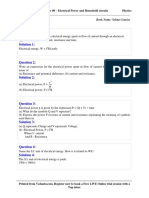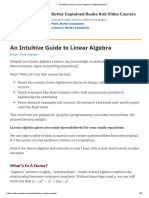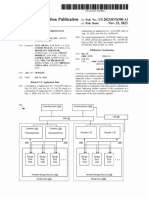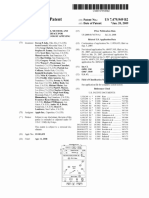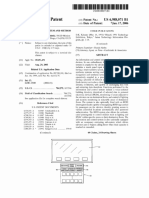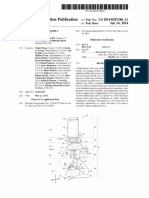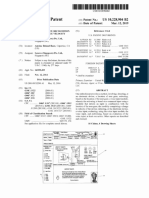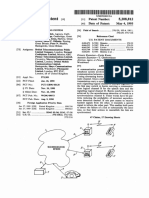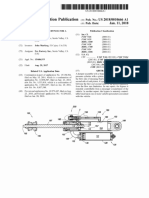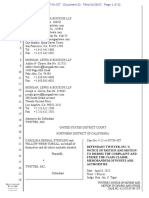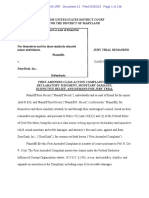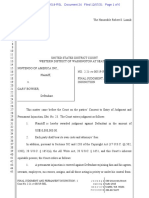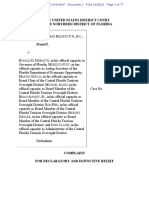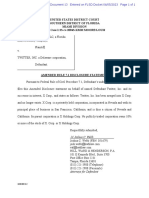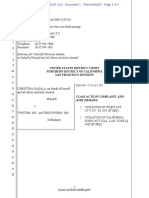0% found this document useful (0 votes)
3K views43 pagesApple Patent Keyword Detection Using Motion Sensing
An apple patent that could use motion data to match reference data for a set of one or more words.
Uploaded by
Gizmodo EditCopyright
© © All Rights Reserved
We take content rights seriously. If you suspect this is your content, claim it here.
Available Formats
Download as PDF or read online on Scribd
0% found this document useful (0 votes)
3K views43 pagesApple Patent Keyword Detection Using Motion Sensing
An apple patent that could use motion data to match reference data for a set of one or more words.
Uploaded by
Gizmodo EditCopyright
© © All Rights Reserved
We take content rights seriously. If you suspect this is your content, claim it here.
Available Formats
Download as PDF or read online on Scribd
/ 43
a» United States
cz Patent Application Publication co, pub. No. US 2023/0245657 Al
LIANG et all (a3) Pub. Date: Aug. 3, 2023
(64) KEYWORD DETECTION USING MOTION Gut 2506 (2006.01)
SENSING G01 15706 (2006.01)
GOL 15/183 (2006.01)
(71). Applicant: Apple Ine., Cupertino, CA (US) G01 1518 (2006.01)
GU6E 3716 (2006.01)
(72) tnventors: Eddy Zexin LIANG, Seattle, WACUS! (52) US CL
Madhu CHINTHAKUNTA, Ssratoga, ce Gte1 1825 (2013.00); GF 20n1
caus) (2013.01); G20L, 1522 2013.01), GIOL 2576
(2013.01); 6101. 15/063 (2013.01); GI0L
18/183 (201501); GIOL 181818 (2013.01)
GU6F 3/168 (2013.01); GIOL 2015223
2013.01)
(21) Appl. Now 18/103,427
(22) Filed: Jan, 30, 2023
Related US. Application Data
(60) Provisional application No, 68/305.535, filed on Peb
on ABSTRACT
Systems and processes for operating an intelligent auto
1, 2022 rated assistant are provided, Ia one embodiment, data is
i received from motion sensor, for instance, recording the
Nee erie) motion of a user as the user utters a spoken input A
6) mec. determination is made whether a portion ofthe motion data
GIOL 1525 (2006.01) matches reference data fora set of one or more words (eg.
GOOF 301
G10L 1522
006.01) f word or phrase) Iso, a task associated with the one oF
(2006.01) ore words i nite in response
108 Sytem
Serve Sr ‘0
Dita Assistant Sever
112 11
Prosessng
Modes baat
Sot WO tetra ta
ES
i
1
Nagaton
Serves)
essing
Seniests)
aledar inerron
Serves Senices)
Enema Servees
US 2023/0245657 Al
Aug. 3, 2023 Sheet 1 of 14
Patent Application Publication
aang
2BDUIED
i i
seoiag feUIEIK3 0 De HaW O)
wai
yao
ancy
on
au
Januag queIsissy FeN5IG
wr Sot wash sang
waisks eon
Patent Application Publication
Aug. 3, 2023 Sheet 2 of 14 US 2023/0245657 AI
Memory 202 Portable Multifunction Device 200
(Operating System L~ 226 [Applications (continued) po 238
[Communication Module L228 | frtap Module oar
[Contactfotion Module [-20 | i i
g 232 | [Browser Module 28
[Graphics Module 1533 | [Calendar Module 249
Haptic Feedback Module + aq | |WidgetModules 1 209.4
etree 238 [Weather Widget() Pr vso2
ule
Digi Assist Oiontodue 17 >re annie ta Les
gi [231 [Calculator Widget ae
lUser Data and Models 236 [Alarm Clock Widget im
[Applications ie
z Tae 237 [Dictionary Widget
stags Noe {238 249-6
[Felephone Module [7230 User Created Widgets) >.
|Video Conference Module 240 | [Widget Creator Module Ln
[E-mail Client Module oat | [Search Module L251
linstant Messaging Module a leven Wes oe
sets ee [7-242 | [Online Video Module
2a |
[Camera Module 1 944 |DeviceiGiobal internal State bX
limage Management Module} 95, 262
Nido & Music Player Module |7~>,, [Ewer Sistem}
JNotes Module Ke ‘extemal Port}
218 RF Circuitry
—— pan 203 28 8 Speaker
204 1] : 203 | “Ratio =a
2m —T] _ Corvoler Circuitry
8 | eioerats | | ao, = iomphone
Interface Proximity me?
sor ie
220 7] Provessor(s) °
‘eoelerometers)
2065 205 =
WO Subsystem
Display Optical intensity Haptic Other Input
Controle 256 |] _Sensor(s) Sensor(s) Feedback |} Controler(s)
7 Controter 258 | | Controller 259 | | Controller 261 260
Yo 203 Fin Fas Fm Fos
Touch Optical Contact Tactile Output |] Other Input
_ Sensitve Sensor(s) Intensity 1] Generator(s)_ |] Conto! Devices
Disa Sytem 264 ae, 267
FAG. 2A
US 2023/0245657 Al
Aug. 3, 2023 Sheet 3 of 14
Patent Application Publication
‘Rianjeg wang
a7 Dd
eeperey
7 wens
Twang \
‘SUORIUYEG BAZ
Beg wong,
ee
‘Ig ewe voneondy
062 seIpueH wang
B__ Jeep ino
Zz s8¥e86n w9I90
3H -aepdn eed
sojesed09
DBZ sezwbooay eng
7oajeoey Wen
O62_seppuey wong
FOzIU6009y WAAT
DBZ sezwBooay wena
‘TSZ warp vogeonddy
we |
‘npoyy seyoiedsiq wang
ee
INDO UORRURLIA}OG
serjtiovey W943 ang
wu |
‘aIMPOWY UOREUMLIOTIG MANA HH
iwt|
Joyo eH
4
JeuOS Wang
TZ maip uoneoyddy
uopeaddy
© sore uoneansdy
Patent Application Publication Aug. 3, 2023 Sheet 4 of 14 US 2023/0245657 Al
Portable Multifunction Device 200
310)
Speaker 211
300
310s SIM card slot
|
312is headphone jack
Touch Screen 2
¢ Contact intensity)
Sensor(s) 28
7 “Tactile Output ~ y
'\ Generator(s) 267.)
‘Microphone Home ‘Accelerometer(s}
28 304 268
[__ Extemal Port 228
FIG, 3
Patent Application Publication Aug. 3, 2023 Sheet 5 of 14 US 2023/0245657 Al
[Operating System [x 226
Memory 470-— [Communication Medule L- 7
(ContactMotion Module oo
Graphics Module x3
Haptic Feedback Module a
[Fext Input Module L- ba
Digital Assistant Client Module Lb
User Data and Models
JApplications 37
[Contacts Module a a
Device 400 [Telephone Module 29
\ [Video Conference Module oan
E-mail Cent Module Bm
instant Messaging Module os
410 cuts) Workout Support Module 043
[Camera Module aon
420 image Management Module a7
Ee
[Browser Module 248
ES rig -
Weather Widget —
{VO interface eater He rr 22
Display = A 440 [Calculator Widget aoe
[Alarm Clock Widget 405
Keyboardiiiouse H— 450 Dictionary Widget 1
[Tat Has lene
Tactile Output [Widget Creator Module 1 951
Generators) t~ 457 [Search Module 252
[video & Music Player Module 1” jon
Sensor(s)__}}—- 459 Drawing Module 482
Presentation Module 1 ‘eh
TENGE [Word Processing Module ae
48Q_| Communications [Website Creation Module 188
Interface Disk Authoring Module a
Spreadsheet Module a
FIG. 4 |DevceiGiobal internal State [57
Patent Application Publication Aug. 3, 2023. Sheet 6 of 14
Portable Multifunction Device
ZB 200 ™~
20g (seaerat ) aS)
500
0
73
Weather
538
Settings
546
O00
©00
eo0
Uiities
Bod 522
Touch Serer
‘Recelerometeris)
258
FIG, 5A
US 2023/0245657 Al
Patent Application Publication Aug. 3, 2023 Sheet 7 of 14 US 2023/0245657 Al
550,
é
Ra
(Tactile Output 1
1 562
\_ Sensors 459 |
FIG. SB
Patent Application Publication Aug. 3, 2023 Sheet 8 of 14 US 2023/0245657 Al
DEVICE
600 608 os
606
FIG. 6A
US 2023/0245657 Al
Aug. 3, 2023 Sheet 9 of 14
Patent Application Publication
sna
g9 OT
WOSNAS
NOLLOW
' S
YOSNAS:
TWNOLLOSMIG
dODSOYAD
SLEWOUTTEOOV] WOSNAS Sd9
NOLLV JINAWINOO|
K
l
I
si9-7] AUOWSIN
(s)¥ossa00¥d]
919.
$297] ALISNALNT
HONOL
AVTASIC
¢
us
INGNI ge
Patent Application Publication
Digital Assistant System
700 Memory 702
\
Aug. 3, 2023 Sheet 10 of 14
‘US 2023/0245657 AI
|Operating System Lx 718
|Communication Module [- 720
[User Interface Module Lr 722
_ 724
[Applications | an
[Digital Assistant Module I 208
iO Processing Module } 730
ISTT Processing Module 1 758
[ASR Systems fee
Natural Language Processing Module }~ 760
[Onictogy im
744
Vocabulary 748
[User Data a TA
jalogue Flow Processing Module} 75.
Task Flow Processing Module 1 754
[Fask Flow Models I~ 238
Service Processing Module 1 I
[Service Models i
L740
7 processors)
[Speech Synthesis Processing Module
TOL,
uN
10 Interface
WO Devices =H 716
moe |
Network Communications
1 interface
Wy Wired Communications
714
Nw
Wireless Circuitry
FIG. 7A
US 2023/0245657 Al
Aug. 3, 2023 Sheet 11 of 14
Patent Application Publication
ai DIT
‘S}aPOW =
MOL ainpo| sasuodsay
yse] Buiss2001g pateag
sisauyukg 7
yooadg sasu0dsey
98 Sapoyy ¥5L poy
Supse00ig Busse001d le—|-__»
Wo} EL ap-nOHes
1 x -
Busse001g
Of
ae AIUD
08
‘ampoyy Buissa90id
BbL vel
vonewesaidey zeL pst
ONBUOU suogejuasaiday 3x2 ||
>
‘annoy vorsianuog ‘ainpowy al L-| Pe
yeqeudiy aauoud Buisse00ld 11S [pas rduy yosods
tee: oes: BL
qweysissy feuSig
US 2023/0245657 Al
Aug. 3, 2023 Sheet 12 of 14
Patent Application Publication
IL DIA
7 abuey 20d
/
ar
277 weueg ~
7 epuwey |
azig hued
auiyelea
urewog
uojenesay uasneyse,
Patent Application Publication Aug. 3, 2023. Sheet 13 of 14 US 2023/0245657 Al
7
808
si0a-t
“HEY SIRI"
nN
sion]
a
ds ‘NEXT SONG
FIG. 8B
Patent Application Publication Aug. 3, 2023 Sheet 14 of 14 US 2023/0245657 Al
900-7
902
OBTAINING A FIRST LANGUAGE MODEL INCLUDE ae
PLURALITY OF REFERENCE DATA FOR A RESPECTIVE FIRST
PLURALITY OF ONE OR MORE WORDS i
1 PLURALITY OF SAMPLE DATA
{| LANGUAGE MODEL INCLUDING A SECOND PLURALITY OF
{ REFERENCE DATA FOR A RESP! ‘OND PLURALITY OF
t SETS OF ONE OR MORE WORDS,
FIRST DATA FROM A MOTION SENSOR
RECEIVING
i VA
DETERMINING WHETHER A PORTION OF THE FIRST DATA,
MATCHES REFERENCE DATA FOR A SET OF ONE OR MORE
PERFORMING A CROSS-CORRELATION BETWEEN THE,
PORTION OF THE DATA AND THE REFERENCE DATA
FOR THE SET OF ONE OR MORE WORDS TO DETERMINE
A SET OF CORRELATION COEFFICIENTS
J | ~s
DETERMINING WHETHER THE SET OF CORRELATION
COEFFICIENTS SATISFIES CORRELATION CRITERIA
a
IN ACCORDANCE WITH A DETERMINATION THAT THE
PORTION OF THE FIRST DATA MATCHES THE REFERENC!
DATA FOR THE SET OF ONE OR MORE WORDS, CAUSING
TASK ASSOCIATED WITH THE SET OF ONE OR MORE WORDS
aE TAe
Lolo
FIG.9
US 2023/0245657 Al
KEYWORD DETECTION USING MOTION
SENSING
‘CROSS-REFERENCE TO RELATED
APPLICATIONS,
10001] This application claims priority to US. Provisional
Patent Application 63/305,535, entitled “USING ACCEL
EROMETER FOR KEYWORD SENSING,” filed Feb. 1,
2022. The contents of this application are incorporated
herein by reference in their entirety.
FIELD
10002] This relates gencrally to intelligent automated
assistants and, more specifically, recognizang voice inputs
‘sing motion sensing
BACKGROUND.
[0003] Intelligent automated assistants (or digital assis
fants) can provide & beneficial interface between umn
users and electeonic devies, Such assistants ean allow users
to interact with deviees or stems using natural language in
spoken andior text forms. For example, user can provide
‘speech input containing a uscr request oa digital sistant
‘operating on an electronic device. The digital assistant can
Jmerpret the vser’s intent from the speech inpat and oper
‘ionalize the users intent ito tasks. The tasks ean then be
performed by executing one or more services of the elee-
‘tonic device, and a relevant output responsive tthe user
request can be returned to the user.
[004] “An electronic device may be controlled using voice
inputs detected using an audi sensor, such asa microphone
incorporated in a phone, hoadset, of smart speaker. Some
voice control systems require sdtional user inputs 10
sctivate, such as bolding down a buton or tapping 2 touch:
seastive surface proe to speaking in order 10 begin detect-
ing audio withthe dio sensor. Other voice contro systems
‘continuously detect and process aio inorder to respond 10
voice inputs vvithout the latency or user effort associated
‘with additional activation inputs. However, continaously
‘detecting and. processing audio data expends power and
processing capacity even when the users not actively using
Voige contol. Additionally, voice coatrol systems ean rest
in false positive responses if the audio sensor picks up
‘ambient noise or specch from an unintended use.
SUMMARY
[0005] Example methods are disclosed herein. An
‘example method includes, tan electronic device having one
fo more processors, receiving fist dats from mation
sensor: determining whether a portion of the fist data
matches reference data for a set of one or more words ad
jin accordance with a determination thatthe portion of the
first data matches the reference data for the set of one OF
ore words, causing a task associated withthe set of ane oF
‘more worde to he iitinted,
[0006] Example non-ansitory computer-readable media
fate disclosed herein. An example notranstory computer
‘eadable storage medium stores one or mere programs, The
‘one or more programs comprise insiructions, whieh when
executed by one or more processors ofan electronic deviee,
cause the clecttnie device to recive fist data fom a
‘motion sensor determine whether «portion ofthe fist data
mmtches reference data for a set of one o more words; and
Aug, 3, 2023
in accordance with a determination thatthe portion of the
fiat data matches the seference data for the set of one oF
more words, cause a task associated with the set of ome oF
‘ore word to be initsted
10007] Example electronic devices are dislosed herein
‘An example electronic device comprises one oe more pro=
jestors 4 memory: and one oF more programs, sere The
fone of more programs are sfored in the memory and eon:
‘gure tobe executed bythe one oF more processors, the one
cor more programs inching instrctions for receiving fst
data froma motion sensor, determining whether portion of
the fist data matches reference data fora set of one or more
words; and in accordance with a determination that the
portion ofthe first data matches the reference data fr the sot
fone or mare words, causing a task associated withthe set
ff one oF more words to be initiate.
10008] An example clectnic device comprises means for
receiving fist data from a motion senso, determining
‘whether a portion ofthe fist data matches reference data for
‘set of one oF more words; and in accordance with
‘determination thatthe portion ofthe first data matches the
reference dala for the set of one oF more words, easing @
task associated with the set of one or more words to be
initiated.
10009] Recognizing a voice input using motion sensing
provides an intuitive and eficent approsch for contelling
an electronic device. When a user speaks, the user's mouth,
ice, head, and neck move and vibrate, Motion sensors sch
as aecelerometers and gyroscopes can detect these motions,
‘while expending relatively litle power eompared to audio
Sensors such as micropbones. Additionally, motion sensors
are Tess ikely than auto sensors to detect ambient sound,
‘och as another person speaking or voices from television
fr stereo, By comparing motion daa 0 reference data for a
eC of one or mor’ relerence words or phrases (e.. voice
commands, in-vocabulary Words, or the like), a matching
reference word or phrase can be determined, Accordingly, a
task associated with the recognized (eg. matching) refr-
fence word of phrase can be initiated based on the motion
data, without nooding to detet of process audio dat
BRIEF DESCRIPTION OF THE DRAWINGS
10010] FG. 1 is 2 block diagram ilustating a system and
environment for implementing a digital assistant, according
to various examples
[0011] FIG. 24 isa block diagram illustrating a portable
‘multifunction device implementing the client-side portion of
1 digital assistant, according to various examples.
[0012] FG. 2B isa block diagram illsteating exemplary
components for event handling, “aeconting #0” various
exannpls.
10013] FIG. 3 illustrates a portable multifunction device
Implementing the cliet-side portion of a digital assistant,
sccorling to varioas examples
[0014] FG, 4a block diagram of an exemplary multi-
Jnetion device with a display and touch-sensitive surfiee,
socording to Various examples.
10015] FG, SA illustrates an exemplary wser interlace for
‘ment of applications on @ portable mullfunetion device,
sccording to various examples
10016] FIG. 8 illustrates an exemplary user interlace for
‘a multfumetion devie witha toveh-tensiive surface tt is
Separate from the display, according t various examples.
US 2023/0245657 Al
[0017] FIG. 6A ihstates a personal electronic device,
‘ocorting to various examples.
[0018] FIG. 6B is block diagram illustrating a personal
clectronie device, according 10 various examples.
[0019] FIG. 7A is a block digram ilusteaing 2 digital
‘sistant system or a server portion thereof, according 10
various examples
[0020] FIG. 72 illuswates the funetions of the digital
assistant shown in FIG. 7A, according to various examples
[0021] FIG. 7C ilusirates @ portion of an ontology,
secording to various examples.
[022] FIGS. 84-88 ilustrte systems for recognizing
voice inputs sing motion sensing, according to various
examples.
[0023]. FIG. 9 illustrates 2 Now diagram for a method for
recognizing voice inputs using motion sensing, acording 10
various examples
DETAILED DESCRIPTION
[0024] Inthe following deserpvion oFexamples, reference
is made tothe accompanying drawings in which are shown
by way of illustration specific examples that can be proc=
jee, It is to be understood that other examples can be weed
and sictral changes ean be made without departing from
the scope ofthe various examples
[0025] Voiee inputs may be recognized using motion
sensing. Using data receive from a motion senso, a dete
mination is made whether a portion of the received data
‘matches reference data fr st of one or more words, the
portion of data matches, «task arsocated with the ct of one
fF more words is initiated
[0026] Aldhough the following description uses terms
“irs.” “Second,” et, to deseribe various clement, these
ements should not be limited by the terms. These terms are
nly used to distinguish one clement from another. For
‘example, a fist input could be termed a second input, and,
Similarly, 2 second input could be termed a fist input
‘without departing from the seope of the varions described
examples. The frst input and the second input are both
inputs and, in some eases, are separate and different inputs
1027] The terminology used in the description of the
various described examples herein is forthe purpose of
‘describing particular examples only andi aot intended to be
Timiting. As used inthe description of the various described
examples and the appended elms, the singular Forms “s,”
an.” and “the” are intended 1 ince the plural Toms 38
wel, unless the context clearly indicates otherwise. It will
also be understood thatthe term “andr” as used herein
refers to and encompasses any and all possible combinations
ff one or more of the associated listed items. It will be
Tuchee understood that the terms “includes,” “neluding,
“comprises.” andor “comprising,” when used in tis specie
‘cation, specify the presence of stated features, integers,
steps, operations, elements, and/or components, bt Jo act
preclude the presence or addition of one or more ether
Tstures, integers, steps, operation, elements, components,
andor groups thereat
0028] "The term "i" may be construed mean “when” or
“upon” of “in response to determining” ee “in response 10
ddetceting.” depending on the context. Simialy, the phrase
“if tis determined” or “if [a stated condition or event] is
detected” may be construc to mcan “upon determining” or
“in response fo determining” or “upon detecting [the stated
Aug, 3, 2023
condition or event)” or “in response to detecting [the stated
condition or event,” Jepending on the context
1, System and Environment
10029] FG, 1 iostates a block diagram of systems 100
according (0 Various examples. In some examples, system
100 implements a digital assistant. The tems “digital assis
tan" “Viral assistant.” “intelligent automated assistant.”
for “automatic digital assistant” refer to any information
Processing systems that interprets natural langage inp in
Spoken and/or texto oem to infer user intent, and performs
sctons based on the infered user intent. For example, to act
‘onan infered user inten, the system perfomns one or more
of the following: identifying a task low with steps and
parameters designed to accomplish the inferred user intent,
‘npuiting specific requirements rom the inferred ws intent
into the tark flow: executing the task low by iavoling
programs, methods, services, APIs, or the like; and gener
sing ouptesponss tothe ter inan able Pest)
10030] Specifically digital assistant is capable of accept
ing user request at Teast partially in the form of a natal
Jagugge command, request, statement, narrative, and/or
nguiy. Typically. the user request seek either an informa
tional answer or perfomance of a task by the digital
sssstant. satisfactory response to the wer request includes
a provision ofthe requested informational answer, a perfor-
‘mance of the requested task, of « combination of the fo.
For example, user asks the digital assistant a question, such
as “Where am I right now?" Based on the user's current
Jocation, the digital assistant answers, “You are in Central
Park near the west gate.” The user also requests the perfor-
mance ofa task, for example, “Please invite my friends 19
iy girlfriends birthday party next week.” In respons, the
digital assisiant can acknowledge the request by saying
“Yes. rght away” and then send a sitable calendar invite on
behalf ef the user to each of the use's frend listed in the
user's electronic adress book, During performance of
reaested tsk, the digital assistant sometimes interacts with
the user in a continuous dialogue involving multiple
exehanges of information over an extended period of time,
There are numerous other ways of interacting with a digital
assistant to request information of performance of various
tasks. In adtion to providing verbal responses and taking
programmed actions, the digital assistant also provides
responses in other visual o aio forms, eg 8 ext, sees,
rnc, videos, animations, ee
[0031] As shown in FIG. 1, in some examples, a digital
sistant i implemented sceording to client-server mel
The digital assistant includes client-side portion 102 (here
alter “DA client 102") executed on user device 104 and
senerside portion 106 (hereafter “DA server 106°)
exectted om server system 108. DA client 102 vommuni-
tes with DA server 106 through one or more networks 110
DA client 102 provides client-side functionalities such a
‘serfacing input and output processing and communication
With DA server 106, DA server 106 provides serverside
unetionaltes for any number of DA clients 102 each
residing on a respective user device 104
0032] In some examples, DA server 106 includes elient-
Tacing UO interface 112, one oF more processing modules
ANd, data and models 116, and VO interface to external
scrvicos 118, The cient-facing VO interface 112 facilitates
the clentfacing input and output processing for DA server
US 2023/0245657 Al
106, One or more processing modules 114 utlize data and
models 16 0 process speech input and determine the user's
intent based on natural language input. Further, one or more
processing modules 114 perform task execution based on
Inferred ser intent, In some examples, DA server 106
‘communicates with extemal services 120 through network
(6) 110 for tsk completion of information acquisition. UO
Interface to extemal servis I18foclifates seh com
cations
10033] User device 194 can be any’ suitable electronic
Udevioe. In some examples, user device 104 is « portable
‘multfunetional device (eg, device 200, described below
With reference to FIG. 24), mulifinetional device (eg,
Advice 400, described below with reference to FIG. 4), or a
personal eleetonic device (ea, device 60, described below
‘ith reference o FIGS. 64-68). portable multifuntional
‘device i, for example, a mobile elephone that also eoatains
bother functions, such as PDA andor muse player Tanctions
Spevitie examples of portable multifunction devies include
the Apple Watch, iPhone, iPod Tou, and iPadto
devices from Apple ine. of Cupertino, Cali, Other examples
of portable multifunction devices include, without limita
ton, earphonesTbeadphones, speakers, and laptop or tablet,
computers. Further, in some examples, user device 104 s a
fon-portable mltfusctional device, In particuls, user
device 104s a desktop compute, a game console a speaker,
1 television, ora television set-op box. In some examples,
tiser device 104 includes « touch-sensitive surface (ea,
touch screen displays andor touchpads). Further, user
device 104 optionally includes one of more ther pysical
userinterface doviees, such as a physical keyboard,
mouse, andior «joystick. Varows examples of electronic
devices, such as) multifuetionsl devices, are described
below in preater del
[0034] Examples of communication network(s) 110
Include local area networks (LAN) and wide area networks
(WAN), eth Internet. Communication network(s) 110 is
Implemented using any known network protocol, inclading
various wired or wiraless protocols, such as, for example,
Fihemet, Universal Serial Bus (USB), FIREWIRE, Global
System for Mobile Communications (GSM), Enhanced Data
GSM Favironment (EDGE), code division multiple access
(CDMA), time division multiple access (IDMA), Bla
tooth, Wi-Fi, voice over Internet Protocol (VoIP), Wie
MAX, or any other suitable communication protocol
[0038] | Secver system 108 is implemented on one or mone
Standalone data processing apparatus ora distributed et
‘work of computers. In some examples, server systems 108
also employs various virtual devicos andlor services of
third-party service providers (eg, think-paryclovd service
providers) to provide the underlying computing resources
andlor infastracture resources of server system 108
10036) In some examples, user device 104 communicates
With DA server 106 via second user device 122, Second user
device 122 is similar or identical to user device 104. For
‘example, second user device 122 is similar to devices 200,
400, oF 600 described below with reference to FIGS. 2A, 4,
land 6A-6B. User device 104 is configured to communica:
‘ively couple w second user device 122 via direct com-
‘munication connection, such as Bluetooth, NFC, BILE, oF
the lke, oF via a wired or wireless network, sic as Toca
WiFi nctwork. In some examples, second user device 122
is configured to at as a proxy betwen user device 104 and
DA server 106. For example, DA client 102 of user device
Aug, 3, 2023
104 is configured to transmit information (ex, a user
request received at user device 104) to DA server 106 via
second ser device 122, DA server 106 processes the infor
‘mation and returns relevant data (eg, data content respon:
sive to the user request to user device 104 via sccond user
device 122,
10037] In some examples, user device 104 is configured 19
communicate bbreviated requests for data to second user
Advice 122 to race the amount of information transmitted
fom user dovice 104. Second user device 122 i configured
to determine supplemental information to add tothe abbee-
ated request to generate complete request to trast 10
DA server 106. This system architecture can advantageously
allow user device 104 having limited! eommunication capa
bilities andor fimited battery power (eg, a watch or a
similar compact electronic device) to access services pro-
vided by DA server 106 by using second user device 122,
having grester communication capabilities andor battery
poser et, a mobile phone, lapiop compurer tablet con-
puter, orth lke), a a proxy to DA server 106. While only
{wo user devices 104 a 122 are shown a FIG. 1, i shoul
be appreciated that system 100 in some examples, includes
any number and typeof user devices configured in his proxy
configuration to communicate with DA server system 106,
0038] Although the digital assistant shown in FIG. 1
Includes both a client-side portion (¢, DA client 102) and
a serverside portion (@£, DA server 106), in some
examples, the Tunetions of @ digital assistant are imple
mented as a standalone application installed on a user
device, In ixition, the divisions of Fuetionalities beeen
the client and server portions ofthe digital assistant can vary
jn different implementations, For instance, in some
examples, the DA client is a thin-lient that provides only
tweer-facing input and output processing functions, and del
cegates all other functionalities of the digital assistant 10 4
backend server.
2, Bletronie Devices
10039] Attention is now directed toward embodiments of
clectronie devices for implementing the client-side portion
of a digital assistant. FIG. 2A is a block diagram illustrating
Portable multifunction device 200 with touch-sensitive dis
lay system 212 in aocordance with some embodiments
Toveh-sewsitive display 212 is sometimes called a “toveh
screen” for convenience and is sometimes known as or
called a “toucheseasitve display system.” Device 200
Jnchides memory 202 (which optionally iachides one or
‘more computer-readable stomge mediums), memory con
twoller 222, one or more processing units (CPUs) 220,
Peripherals interface 218, RF cirevitry 208, aio ciruitey
210, speaker 211, microphone 213, inputoutput (UO) sub-
system 206, exer input control devices 216, and external
port 224, Device 20 optionally includes one or more optical
Sensors 264. Device 200 optionally includes one or more
contact intensity sensors 268 for detecting intensity of
contacts on device 200 (eg. a touch-serstve surface such
touch-sensitive display “system 212 of device 200)
Device 200 optionally incides one or more tactile ouput
enerators 267 for generating tactile ourpus on device 200
{eas generating tactile ontpits on a touch-sensitive sure
such as touch-sensitive display system 212 of deviee 200 or
touchpad 488 of device 400). These components optionally
communicate over one oF more communication buses oF
signal fines 20.
US 2023/0245657 Al
[0030] As used inthe specification and clams, the term
“intensity” ofa contact on a touch-sensitive surface refers
the force or pressure (fore per unit area) of a contact (eg,
1 finger contact) on the touch-sensitive surface, of 10.
Substitute (proxy) Toe the force oe pressure ofa contact on
the touch-sensitive surface, The intensity of @enatact has 4
range oF vals that includes atleast Fou dstnet valves and
‘ore typically eludes hundreds of distinct values (6, at
Teast 256), tensity ofa contact s, optionally, determined
(ce measured) using various approaches and various sensors
br combinations of sensors. For example, one cr more force
sensors underneath or adjacent tothe touch-sensitive sures
ar, optionally, used to measure force at Various poins on
the touch-sensitive surface. In some implementations, force
measurements from mulple force sensors are combined
(ea weighted average) to determine an estimated fore of
1 contact. Similarly. a pressure-seastive tip of a stylus is,
‘optionally, sed to determine a pressure ofthe stylus on the
touch-sensitive surlace. Alteraively, the sizeof the contact
area detected on the touch-sensitive surface and/oe changes
‘hereto, the capacitance ofthe touch-sensitive surface proxi
mate To the contact andlor changes thereto, andlor the
resistance of the touch-sensitive sirface proximate to the
contact andor changes thereto are, optically, use as
substtme forthe force of pressure of the contact on the
‘ouch-scastive surface. In some implementations, the sub-
stitute measurements for contact foree or pressure are used
directly to determine whether an intensity threshold hasbeen
exceeded (ez, the intensity threshold is described in nits
forresponding to the subsite measurements). In some
Implementations, the substitute measurements for contact
force of presture are converted to an estimated force or
pressure, and the estimated force or pressure is used 19
‘termine whether an intensity threshold has been exceeded
(eg. the intensity threshold is 4 pressure thresbold met
sured in units of pressure). Using the intensity of contact
28 an attribute of a user input allows for user access 0
additonal device functionality that may otherwise not be
aocessble by the user ona reduced-sze device with limited
real estate for displaying affordances (eg., on a touch:
Sensitive display) andor receiving user input (eg. via @
touch-sensitive display. a touch-sensitive surlae, ora physi-
callmechanical contol such asa knob or 2 button).
[0081] As used inthe specification and claims, the tem
“getle ouput” refers to plisical displacement of a device
relative toa previous position of the deviee, physeal dis-
placement ofa component (eg. a touch-sensitive surlace) of
‘dvice relative to another component (e.g, housing) ofthe
‘device, or displacement ofthe component relative ton center
‘oftmass ofthe device that willbe detected by a user with the
user's sense of touch, For example, in situations where the
device or the component ofthe device isin eontact with a
surface of a user tht is sensitive to toveh (ea finger,
palm, of other part of # user's hand), the toile ouput
tzenerated hy the physical displacement will be interpreted
by the ter a8 toctile sensation corresponding to. per
coived change in physical characteristics ofthe dove of the
component of the device. For example, movement of
touch-sensitive surface (eg, a touch-sensitive display or
‘eackpad) i, optionally, interpreted by the user as a “dovsn
click” or “up click” of a physica actuator button. In some
‘cases, user wil fool a tactile sensation such as an “down
Click or “up click” even when there is a0 movement of
physical actuator button associated with the touch-sensitive
Aug, 3, 2023
surface that is physically pressed (eg, displaced) by the
tser's movements. As another example, movement of the
touch-semsitive surfce is, optionally, interpreted or sensed
by the user as “roughness” of the touch-sensitive surface,
even when there is no change in smoothness of the touch
sensitive surface, While such interpretations of touch by a
‘user wil be subject tothe individualized sensory perceptions
ofthe use, there are many sensory pereptions of touch that
arecommon oa large majonty of users. Ths, when a tele
‘output is described as corresponding toa particular sensory
perception of @ user (ean “up clic,” a “down click”
“roughness”, unless otberwise stated, the generated tactile
contpat comresponds to physical displacement ofthe devie or
‘component thereof tha wll generate the described sensory
perception fora typical (or average) user,
10042] Itshoukd be appreciated that device 200 is only one
cexaniple of portable multifunction device, and tat devise
200 optionally has more or lower components than shossn,
optionally combines two or more components, or optional
has a diferent configuration or arrangement of the compo=
nents. The various components shown in FIG. 2A are
‘implemented in hardware, software, or 4 combination of
both hardware and software, including one or more signal
processing andlor aplication-specifc integrated cir
[0043] | Memory 202 includes one or more eomputer-read:
able storage mediums. The eomputer-readable storage med
‘usar, for example, tangible and non-transitory. Memory
202 includes high-speed random aceoss memory and als)
Jncludes non-volatile memory, such 2s one or more magnetic
disk storage devices, lash memory devices, or eller non-
volatile solid-state memory devices. Memory controller 222
controls access 19 memory 202 by other components of
device 200,
10044] In some examples, a non-ransitory eomputer-read-
able stomge medium of memory 202 i8 used to store
instructions (ee, for perlonning aspecis of processes
described below) for use by of in connection with an
Instruction execution system, apparatus, or device, such as a
computer-based. system, processorcontaining system, oF
‘ther system that can fetch the instructions from the instr
tion exceution system, apparatus, or device and execute the
instrtions. In other extumples, the instructions (ee, for
performing aspects of the processes deserbed below) are
SHored on a non-ransitory computerteadable slonige
‘dium (aot shown) ofthe server system 108 or are divided
between the non-tnusitory “computer-readsble songs
medium of memory 202 and the non-transitory computer:
readable storage medium of server system 108
10045] Peripherals interface 248 is used 1 couple input
and output peripherals of the device to CPU 220 and
‘memory 202, The one or more processors 220 run or execute
various software programs andr sets oF instructions stored
‘memory 202 (0 perform various functions for device 200
and to process data. In some embodiments, peripherals
Interface 218, CPU 220, and memory controller 222 are
Implemented on a single chp, such as chip 204. In some
other embodiments, they are implemented on separate chips
[0046] RF (radio frequency) circuitry 208 receives and
fends RF signals, also called eloctomagnetie signals, RF
circuitry 208 converts electrical signals to/from eletromag-
netic signals and communicates with communications net
works and other communictions devices via the clecro-
‘magnetic signals. RF circuitry 208 optionally includes wel-
known eireuitry for performing these functions, including
US 2023/0245657 Al
bc not inte an antenna system, an RF transceiver, one
crmmore amplifiers, uae, one oF sar seit, digit
Slgnal processor CODEC chipst subseber ideality
tmodule (SIM) car, memory, and so Forth. RE ciety 208
ionally communicates wih newer, such the Inte:
flan refer to as the World Wide Web (WWW), 28
inanet andor a witeless network, suchas a cea ele
phone network, wiles lea area network (LAN) aor
8 metropolitan area network (MAN), and other devies by
Wwirelest communication, The RF crt 208 optionally
includes well-known eeu for detecting nea Hel com
‘usicaton (NFC) lds, sucha by a shor-apge comm
cation ado. The wisest commniation optionally cs
any of pry of communications andar, potas,
and ecologies incling but mot intel o Glob System,
for Mobile Communications (GSN), Fahaneed Data GSM
Environment (EDGE) high-speed dowalink packet access
(CISDPAY, high-speed uplink pocket acess (HSDPA), Ev
lotion, DatrOnly (EV-DO), HSPA. HSPAs, Dual
FHSPA (DC-HSPDA), long tc evolution (CTE), nee Held
communication (NPC), wideband code dvs lite
access (W-CDMA), code vison muiple access (CDMA),
time division multiple seces (TDMA), Bluetooth, Bit
etwoth Low Enemy (BTL), Wireless Fidelity (WEE) (ex,
TSE 8021s, IEEE 802.16, IEEE 802.11, IEEE 8021,
ane IEEE 802 1a), wiee ove Internet Protocol (VP),
WeMAX, a protocol fore mal (eg. Item message
access protacl IMAP) anor post ofce protocol POP)
instam messaging (eg, extensible messaging and presence
protocol (XMPP}, Sesion Tritton Proweol Tor Tastant
Messaging and Presence Leversaing Extensions SIMPLE,
Instant Mesuing and Presence Service (IMPS), andor
Short Messe Service (SMS). cr any le suitable com
nication protocol including communication protocols
fot yet developed at ofthe filing date of thi document.
[0087] Audio ciruiy 210, speaker 211, nd microphone
213 provide an aio interface between 8 user and device
200, Nalin cicuity 210 receives suo data fram pexph=
tral interce 218, converts the ado data to an electrical
Signal, and transmits the electrical signal 1 speaker 211
Speaker 21 converts the clerical inet human-uile
sound waves. Audio circuitry 210 also revives electical
Signals converted by microphone 213 fom sound waves
Adio ezeuiey 210 covers the electrical signal o aio
data and rans the aio dato pripiras ntrface 218
fr processing. Audio data are retseved rm sno trans
ried 9 memory 202 andor RF circuitry 208 by pecnh-
eras interface 218. In some embodiments, andi cireey
210 aso iacudes a Ieadset jack (e312, IG. 3). The
ict jack provides a interface betwoon aio cicitey
210 and remable aio iapatoutpa peripheral, soc as
uiitcoly hemes ra ede wit hot out (ea,
‘headphone fr one or both eas) and iat (eg, 8 mie
phone)
{0048} 10 subsystem 206 couples inpuoutpt periper
aly om devie 20, much as touch Sreen 212 an othe input
onto devies 216, o peripherals interes 218. 10 sub
System 206 optionally includes display controller 256, op
Gal sensor conor 258, iatensty sensor controler 259,
haptic feedback controller 261, and one or moe input
conrller 260 footer input or contol devices. The une ur
‘nore input contllers 260 reccivelsend cletrial signal
fromto other it contol devices 216. The oer input
contol davies 216 optionally include physical butions
Aug, 3, 2023
(ean push burtoas, rocker buttons, ete), dials, slider
switches, joysticks, fick wheels and so forth. In. some
alternate cmbodiments, input contrller(s) 260 are, option-
ally, coupled 10 any (or none) ofthe following: a keyboard,
an infrared port, USB por, and a pointer device such as 4
mouse, The one or more buttons (€2, 908, FIG. 3) option-
ally inelide an upidown bution for volume eon) of
speaker 211 and/or microphone 213. The one or more
buttons optionally include a push button (¢g, 306, FIG. 3).
10049] _ quick press of the push button disengages a lock
ff touch sergen 212 or hegin a process that uses gestures on
the touch screen to unlock the device, as desribed in US.
patent aplication Ser No.11/322,549, “Unlocking a Deviee
by Performing Gestures on an Unlock Image,” fled Dee, 23,
2005, US. Pat. No. 7,657,849, which is hereby incorporate
by reference in its entirety. longer pres ofthe pus button
(Gu 306) tums power ta device 200 on or of. The user is
able to customize a functionality of one er more of the
buttons. Touch sersen 212 is wsed to implement vital or
soft batons and one or more salt keyboards.
0050] Tovch-sensitive display 212 provides an_ input
fnterfae and an output interfce between the deve snd
user Display controller 256 receives andr sed electrical
signals fromito touch sersen 212. Touch sercen 212 displays
‘stl ouput tothe were visual output incidesgropt-
jes, text, icons, video, and any combination thereof (colle
tively termed “graphics”, In some embodiments, some or
all ofthe visual output correspond to user-interface objects
10051] Touch sereen 212 has a touch-sensitive surfiee,
Sensor, or set of sensors that accepts input fom the user
bused on hapic andr tactile contac, Tech sreea 212 ad
display controler 286 (along with any associated modules
andlor sets of instructions in memory 202) detect contact
(and any movement or breaking of the contaet) on touch
sereen 212 and convert the detected contac into interaction
with userinterface objects (eg, one oF mone soft Keys,
Jcons, web pages, or images) that are displayed on touch
screen 212. nan exemplary embodiment, point of contact
between touch soreen 212 and the user comesponds to a
finger of the user.
10052} Touch screen 212 uses LCD (gui crystal display)
technology, LPD (light emitting polymer display) tecno}
ogy, of LED (light emitting diode) technology, although
other display technologies may be wsed in other embod
ments. Touch sereen 212 and display controller 286 detect
contact and any movement or breaking thereof using any of |
plurality of touch sensing technologies now known or later
developed, including but not limited to eapacitive, resistive,
Infrared, and surface acoustic wave technologies, 38 well 3s
other proximity sensor arrays oF other elements for deter
mining one or mor: points of contact with touch sereen 212,
Inan exemplary embodiment, projected mutual capacitance
sensing technology is used, such as that found in the
‘hone and iPod Touch from Apple Inc. of Cupertino,
Cait
10053] touch-sensitive display in some embodiments of
‘ouch sereen 212 is analogous 0 the mul-toueh sensitive
‘ouchpods described in the Tallowing U.S, Pat. No. 6.323,
846 (Westerman ea.) U.S. Pat, No. 6,570,857 (Westerman
eta), andior US. Pat No. 6,677,932 (Westerman), and/or
US. Patent Publication 200200150241, cach of which is
hereby incorporated by reference in its entirety. However,
US 2023/0245657 Al
‘ouch sereen 212 displays visual output from deviee 200,
whereas touelisensiive touebpads Jo not provide visual
output
10084] A touch-sensitive display in some embodiments of
touch sereen 212 is as described in the following applica
‘ions: (1) U.S, patent application Ser. No, 11/381,313,-"Mul-
‘ipoint Toveh Surface Controller
US. patent application Sex. No. 10840,862,
‘Touehseroen," led May 6, 2004: (3) U.S, patent appicstion
Ser. No. 10/903,964, “Gestures For Touch Sensitive lapt
Devices.” file Jul. 30,2004: (4) U'S. patent application Ser.
No,_ 11/048,264,
Deviees," fled Jan. 31, 2008; (5) US. patent application Ser.
No. 11038,90, "Mode-Based Graphical User Intorfaces
For Touch Sensitive Input Deviees." led Jan, 18, 2005; (6)
US. pateat application Ser, No, 1/228.788, "Viral Input
Device Placement On A Touch Sereen User interface,” filed
Sep. 16, 2005: (7) US. patent application Sor. No. 11/228,
700, “Operation OF Computer With A Touch Sereon
Interface,” fled Sep. 16, 2005; (8) U'S. patent application
Ser. No, 11/228,737, “Activating Viral Keys OF A Touch
Sereen Virtual Keyboard,” filed Sep. 16, 2005; and (9) US.
patent application Ser. No. 11/367,749, “Multi-Function
Hand-Held Device,” fled Mar. 3, 2006 AIL of these appli
cations are incorporated by reference herein i thei entirety
[0055] Touch sercen 212 has, for example, a video rs
Iution in excess of 100 dpi. some embodiments, the tovel
screen has a video resolution of approximately 160 dp The
User makes contact with touch sereen 212 using any sbitable
‘objector appendage, such as a stylus, a finger, and so forth
Tinsome embodiments, the user interface is designed to work
primarily with finger-hsed contacts and gestures, which ean
be less precise than styls-hased input dv to the larger aa
‘of contact ofa finger on the touch screen. In some embodi-
‘ments, the device translates the rough finger-basod np ito
‘aprevse pontercursor postion or command fo performing
the actions desired by the user.
10056] In some embodiments, in addition to the tovch
screen, device 200 includes « touchpad (not shown) for
fctivating or deactivating. particular functions. In some
tembodiments, the touchpad is touch-sensitive area of the
‘device that, unlike the touch sere, does not display visual
output. The touchpad is @ touch-sensitive surface tht is
Separate from touch sereen 212 or an extension of the
touch-sensitive surface farmed by the touch sereea
10057] Device 200 also includes power system 262 for
powering the various components. Power system 262
Includes a power management systom, one or more power
souroes (eg, battery, altemating eurent (AC)), recharging
system, a power failure detection ctcit,@ power converter
br imerter, a power status indicator (ea Hab-emitting
ttode (LED)) and any other components associated with the
teneration, management and distribution of power in por
able devices,
[0058] Device 200 also includes one or more optical
sensors 264, FIG, 2A shows an optical sensor coupled to
‘optical seasor contoller 258 in LO subsystem 206. Optical
sensor 264 includes charge-coupled device (CCD) or
‘onplementary’ metal-xide semicondnctor (CMOS) pho-
‘otransstors. Opiical sensor 264 receives ligt from the
fenviroament, projected through one oF more lenses, and
‘converts the light to data representing an image. In conjune-
fon with imaging module 243 (also called a camera mod
tle), optical sensor 264 captures stil images or video. In
Aug, 3, 2023
some embodiments, an optical sensor is located on the back
of device 200, opposite touch sereen display 212 on the front
ofthe device so thatthe touch sercen display ie used as
‘iewiinder for sill andor video image soquistion. In some
embodiments, an optical sensors keaton the frat of the
device so that the user's image is obtained for video con-
ferencing while the user views the other video conference
participants on the toveh sereen display. In sonie embodi-
ments, the postion of optieal sensor 264 can be changed by
the user (eg. by rotating the lens and the sensor in the
device housing) so that a single optical sensor 264 is use
slong with the touch screen display for both video confer-
fencing and sill andor video image acquisition,
0059] Device 200 optionally also includes one or more
contact intensity sensors 268, FIG, 2A shows a contact
Intensity sensor coupled to intensity sensor controller 289 in
VO subsystem 206, Contact intensity sensor 268 optionally
Jnchides one or move piezoresistive stain gauges, capacitive
force sensors, electne Toree sensors, piezneletrie force
sensors, optical force sensors, capacitive touch-sensitive
surfaces, oF otier intensity sensors (eg Sensors Used 10
measure the force (or pressure) of a contact on a touch
sensitive surfce). Contact intensity sensor 268 receiver
contac intensity information (eg. pressure information ora
proxy for pressure infomation) from the environment. In
Some embodiments, atleast one contact intensity sensor is
collocated with, or proximate to, 2 touch-sensitive surfice
(touch-sensitive display system 212). In some embodi-
ments atleast one contact intensity sensor is located on the
back of device 200, opposite touch screen display 212,
‘whic i located on the Iroat of device 20,
10060] Device 200 also includes one oF more proximity
sensors 266. IG, 2A shows proximity sensor 266 coupled
to peripherals interface 218, Altematly, proximity sensor
266 is couple to input controller 260 in 1 subsystem 206.
Proximity sensor 266 is performed as described in US.
patent application Ser. No. 11/261,839, “Proximity Detector
Jn Handheld Device", Ser. No. 11/240,788, “Proximity
tector In Handheld Device”; Ser. No. 11/620,702, “Us
Ambient Light Sensor To Aygmeat Proximity Sensor Out-
put"; Ser, No, 11/886,862, “Automated Response To Aad
Sensing Of User Activity In Potable Devices"; and Ser. No.
11/638,281, "Methods And Systems For Aulomatie Con
figuration Of Peripherals” which are herehyincorporatd by
reference in their entirety. In som embodiments, the prox-
Jmity sensor tums off and disables touch sereen 212 when
the multifunetion device is placed near the users ea (€2
when the user is making 4 phiooe call)
0061} Device 200 optionally also includes one or more
tacile output generators 267. FIG. 2A shows tactile ouput
enerator coupled to haptic feedback controller 261 in iO
subsystem 206, Tactile output generator 267 optionally
Jnchides one or more electronic devices such #s speak
cs of other audio components andor eleciromechsnical
devices that convert energy into linear motion such as a
rotor, solenoid, electroactive polymer, piezoelectric actua-
tor, elctostatie actuator, of other tactile output generat
component (e., a component that converts electrical sig
nals into wetife outputs on the device). Contact intensity
sensor 265 receives tactile feedback generation insivetions
fom haptic feedback module 233 and. generates tactile
cotpats on device 200 that are capable of being sensed by a
twscrof device 200, In some embodiments at least one tactile
foutpot generator is collocated with, oF proximate to, a
US 2023/0245657 Al
touch-sensitive surface (e touch-sensitive display system
212) and, optionally, generates a tactile ouput by moving
the touch-sensitive surface vertically (eg. inut of sur
face of device 200) or laterally eg, back and forth in the
same plane a & surface of device 200), ln some embod
‘ments at least one tactile omtput generator sensor is located
fon the back of device 200, opposite touch sereen display
212, whichis located on the front of device 20,
[0062] Device 200 also inchides one or more acelerom:
ser 268, FIG. 2A shows accelerometer 268 coupled 10
Peripherals interface 218. Allemately, aooclerometer 268 is
‘ouped fo an input contmller 260 in LO subsystem 206,
Accelerometer 268 performs, for example, as described in
US. Patent Publication No. 20050190059, "Acceleration
bused Theft Detection System for Portable Electronic
Deviees,” and US. Patent Publication No. 20060017692,
“Methais And Apparatuses For Operating A Portable
Device Based On An Accelerometer” both of which are
incorporated by reference herein in their entirety. In some
embodiments, information is displayed om the touch sercen
Aisplay in portrait view ora landscape view based on at
lysis of deta received from the one or more aeelerom
ters. Device 200 optionilly includes, in addition to accel
‘erometers) 268, a magnetometer (not shawn) and 8 GPS (or
GLONASS or other global navigation system) receiver (oat
shown) for obiining information concerning the location
tnd orientation (eg, portrait or landscape) of device 200,
10063] Ia some embodiments, the software components
‘sored in memory 202 include operating sytem 226, com
‘munication module (or set of instructions) 228, contac!
‘motion module (or set of instrctions) 28, graphics module
(or set of instructions) 232, text input module (or set of
instructions) 234, Global Positioning System (GPS) module
(6 set of instructions) 238, Digital Assistant Client Module
229, and applications (or ses of insrtions) 236, Further,
‘memory 202 stores data and models, sich as user data ad
‘models 231. Furthennore, in rome embodiments, memory
202 (HG. 2A) of 470 (FIG. 4) stores device’ global internal
State 257, as shown in FIGS. 2A and 4, Devicelglobal
Jnteral state 257 includes one or more of: ative application
state, indicating which applications, if any, are curently
active; display ste, indicating what applications, views or
ther information occupy various regions of touch sereen
Aisplay 212; seasor state, including information obtained
trom the device's various sensors and input control devices
216; and location information eonceming the device"s hoe
tion andlor atiude
[0064] Opersting system 226 (e.g. Dania, RIXC,
LINUX, UNIX, OS X, 108, WINDOWS, of an emboddod
‘operating system such as VxWorks) inclades various sot-
‘ware components andlor divers for controling and manag-
ing general system tasks (eg, memory management, stomge
components,
10068] Communication module 228 facilitates commnni-
cation with other devices over one or more extemal ports
224 and also includes various software components fOr
handling data received by RF eteutry 208 and/or exec
pon 224, External port 224 (eg., Universal Serial Bus
(USB), FIREWIRE, et.) is adapted for coupling directly 10
other devices or indirectly over a network (€ the Inter,
Wireless LAN, etc). In some embodiments, the extemal port
js a multipin (eg, 30-pin) connector that is the same 28, or
Aug, 3, 2023
sinilarto andioe compatible with, the 30-pin connector used
‘on iPod® (trademark of Apple Inc.) Jeviees.
10066] Contaevotion module 230 optionally detects con-
tact with touch screen 212 (in conjunction with display
controller 286) and other touch-sensitive devices (e@., 8
touchpad or physical click whl). Contact motion made
230 includes various software components for peroeming
various operations related to detection of contact, such 2
determining if contact has occured (e. detectng finger
‘dvin event), determining an intensity of the contact (eg,
the force or presture of the contactor a substitute foe The
Torce or pressre of the contet), determining if there is
ovement ofthe contact and tracking the movement scrost
the touch-sensitive surface (eg. detecting one or more
finger-dragging events), and determining ifthe contact has
cussed (eg, detecting & fingerup event or a Break in
ontaet) Contactimotion module 230 roveives contaet data
liom the touch-sensitive surface, Determining movement of
the point of contact, which is represented by a series of
contact data, optionlly includes determining speed (m0
nitude), velocity (magnitude and direction), andor an accel
eration (a change in magnitude andor direction) ofthe point
ffcontaet These operations are optionally, applid to single
contacts (eg, one finger contsets) or to moltipl simulta-
neous contacts (eg. “multitouch” multiple finger contacts).
Tn some embodiments, contaeVmation module 230 aad
display controller 256 detect contact on a touchpad
10067] In some embodiments, contactimotion module 200
Uses «set of one oF more inensly thresholds to detennine
‘whether an operation has boon performed By @wser (©. 19
determine whether a user bas “clicked” on an icon) In some
embodiments at last a subset of the intensity thresholds are
determined in accordance with software parameters (€,
the intensity thresholds are not determined by the activation
thresholds of particular physical actuators and can be
adjusted without changing the physical hanlware of device
200), For example, a mouse “click” threshold ofa trackpad
or touch sereen display can be sct to any ofa lange range of |
predefined threshold values without canging the trackpad
fr touch sereen display hardware. Additionally. in some
implementations, a user of the doview is provided with
software settings for adjusting one oF more of the set of
intensity thresholds (e., by adjusting individual intensity
thresholds andr by adjusting a plurality of intensity thresh-
olds at once with system-level click “intensity” parameter).
10068] Contaetimotion module 230 optionally detects
gesture input by a user. Different gestires on the touch
ensitive surlice have difleent contact pattems (eg. dif
erent motions, timings, andor intensities of detected! con-
tacts). Thus, a gesture is, optionally, detected by detecting a
particular contact pattem. For example, detecting a finger
tap gesture includes detecting a finger-down event followed
Hingee-up (fil) event atthe same pos
the same postion) asthe finger-down event
(@g., at the positon of an icon). AS another example,
detecting a finger swipe gesture on the touch-sensitive
surface includes detecting a finger-down event followed by
detecting one or more finger-drapging events, and subse-
quently followed by detecting a finger-up (lift?) event
10069] Graphics module 282 includes various known sot-
ware components for rendering and displaying graphics on
touch seroen 212 or other display, incloding components for
changing the visual impact (e., brightness, transparency,
Saturation, contas, or ther visual property) of aaphics i
US 2023/0245657 Al
are displayed, As used herein, the term “graphics” includes
any object that ean be displayed toa user, including, without
limitation, text, web pages, icons (such as user-interface
objees including soft keys), digital images, videos, anima
tions, and the like
10070] In some embodiments, graphics module 232 stores
data representing graphics to be used. Bach graphic is,
‘optionally, assigned a coresponding code. Graphics module
252 rocowves, irom applications ete, one oF more codes
‘positing graphs 1 be displayed along with, if necessary,
soordinate data and other graphie property data, and then
tzeneatessereen image data to output to display’ controller
256.
[0071] _Hepsic feodback module 233 includes various soft-
‘ware components foe generating instructions used by tactile
output generator(s) 267 t produce tate outputs al one or
‘more loations on device 200 in response to user interactions
swith device 200,
[0072] Text input module 284, which is, in some
‘examples, a component of graphies module 232, provides
sof keyboards for entering text in various applications (eg.
‘contacts 297, email 240, M241, browser 247, and any oer
sppliction that needs text ips),
10073] GPS module 288 determines the location of the
device and provides this information for use in various
applications (eto telephone 238 for use in location-based
ating: to camera 243 as picturevideo metadata; and 10
‘applications that provide location-based services sich a
Weather widgets, local yellow page Widgets, and mep!
navigation widgets).
[0074] Digital assistant client module 229 includes va
‘ous client-side digital assistant instructions to provide the
client-side funetionaliGes of the digital assistant. For
example, digital assistant client module 229 is capable of
sccepling voice input (eg. speech input, text input, touch
Input, ander gestural input through various user interfaces
(©, microphone 213, accelerometers) 268, 1och-sensi
ive daplay system 212, optical sensors) 264, other input
control deviees 216, te) of porable multifunction device
200, Digital assistant cleat module 229 is also capable of|
providing output in_ audio (eg. speech output), visual,
andlor tactile forms through various output interfaces (eg.
Speaker 211, touch-sensitive display system 212, tactile
futput generators) 267, ete.) of porable multifunction
device 200, For example, utpot is provided as voice, sound,
ers, text messages, menus, graphies, videos, animations,
‘bration, andlor combinations of two oF more ofthe above.
During operation, digital assistant client module 229 com
municates with DA server 106 using RE circiry 208
10075] User data and models 281 include various data
associated with the user (eg, user-specific vocabulary data,
user proference data, userspecified name pronunciations,
data from the user's electronic address book, to-do list,
shopping lists, et.) to provide the client-side functionalities
of the digital assistant. Further, user data and models 231
include various models (eg. speech recognition models,
Matistical Langwge models, natural language processing
‘models, ontology tak low models, service models, et) for
processing use input and determining. usr ten
[0076] In some examples, digital assistant cient module
229 ullizes the various sensors, subsystems, ad peripheral
‘devices of portable mutifametion device 200 to gather
‘ditional information from the surrounding environment of
the portable multifunction device 200 to establish a context
Aug, 3, 2023
associated wih a ser, the current use iteration, andlor
the current use put In some exaapls, digital asistant
clout module 229 provides the context information or a
Subset hereof will the user inp to DA sever 106 to bp
forthe o's inal, Ia somcexanpes, the digital assistant
0 snes the conten information to determine how fo
prepare an deliver outputs othe use. Contextual informa
tion i refered to as context dita
{0077 "Insome examples the contextual infomation tat
accompanies the user input includes sensor information,
eng, ambient nose, ambien eroperstrs, images or
‘idos of the surrounding ‘covionment, cc. Ia some
xampes, the context infomation ean also include the
piel state ofthe device, e., device orientation, device
Fheation, device temperature, power lve, sped, acceler
‘ion, moion patents, cellular signals seength, et. In some
examples, infomation rated wo the software site of DA
Server 106, nnning process, installed programs, past
fnd preseat nctwork atic, background services. for
toga resources usage, ete, and of porable mutation
device 200 is provided to DA server 106 at contextial
information asocited with 2 user np
[0078] In some example, the digital assistant clint mod
le 229 seletvely provides information ser dts 231)
stred oa te portable mulfuntion device 200 in response
to raqests fmm DA server 106. In some eximpes, digit
sistant clint mole 229 alsa elicits tonal np om
the mer via a natural langinge dislogne or oer ser
interfaces upon request by DA server 106. Digit assistant
client module 229 passes the additonal input to DA server
196 to belp DA server 106 in intent dedvetion andor
Fallment othe users intent expres inthe usr reqs
{0079} A more deuiled description fa Ug asstan is
desribed blow with reference FIGS, ZAC. ltshould Be
recognized that digital assistant clit module 229 can
inclade any number ofthe subsmoduls of digital assistant
module 726 described below
[0080] Applications 236 inchnde the following modules
(or ses of ststretions), or 2 subset of superset hero
10081) Coniets module 237 (sometimes called sn
dress book or conc st}
0082] Telephone module 238:
0083] Vidco conference module 239:
0084] E-mail elieat module 240,
008s] Instant messaping (IM) module 241:
{0086} Workout support module 242:
0087] Camera module 243 for sill andlor video
images:
0088] Image manggement module 244;
[0089] Video player module;
[0090] Music player module:
[0091] Browser module 247;
10092] Calendar module 248;
10093] Widget modules 249, which includes, in some
‘examples, one or more of: weather widget 249-1,
Stocks widget 249-2, calelator widget 249-3, larm
‘lock widget 249-4, dictionary widget 249-5, and other
Widgets oblained by the user, ak well as user-reated
widgets 249-6;
[0094] Widget ereator module 250 for making. wer
created widgets 249-6;
0095] Search module 254;
10096] Video and music player module 282, which
merges video player module and musie player module;
US 2023/0245657 Al
(0097)
{oo}
Notes move 253;
‘Map module 254; andor
[089] Online vikeo module 258
{0100} Examples of otber applications 286 that are stored
sn memory 22 inclade other word processing apliations,
oor ings editing applications, drawing applications, po
Seatation aplicatons, JAVA-emabledapplicadons, encnyp-
tion, digital rights management, oie revogiton, and voice
replication
[0101] To conjunton wih touch sereon 212, display
contol 286, ontsev motion mexile 230, graphics module
252, and text input module 234, conscs medile 297 are
‘si fo manage an adress book or contact list (ea stored
in application internal state 292 of eontaets module 297 ia
‘memory 202 or memory 470), including adding name(s) 10
the dates book deleting name(s) from the aes book
assocaing telephone numbers), eal adres(s), ps
Cal address(es) rater information with name associating,
fn image wih a name, eatgorizing snd sorting names,
providing telephone nombers oF email aes 4 ite
noe fiat communications by telephone 238, video
enferenve module 239, emai 240, or IM 241 and so Forth
[0102] In conjunction with RF circuitry 208, ai ee
Cairy 240, speaker 21, microphone 213, touch sree 212,
Asp conte 256, contact motion module 29, graphics
module 232, and text input module 24, telephone module
238 wed to euer a sequence of darcterscomespoaling
to telephone number sees one oF more telephone ai
bers in contac module 257, modi telephone number
that has Boon entre, il rspotve telephone numb,
conve a convertion, and disconnect or hangup when he
conversation is completed. As noted above the wireless
emmonicaton ase any of «plurality of commaniatons
Standards, protocols, and techaologies.
{0103}. Ia conjuacion with RE ciety 208, audio ci
cuitry 240, speaker 21, microphone 213, touch sereen 212,
splay controler 286, opal sensor 268, optical snsor
conoler 28, contseUnotion male 230, graphics module
232, text input module 234, contact: mode 297, ad
‘elephone module 238, video conference module 239
Jncindes executable iasirictions (0 iaiate, conde, ad
terminate video conference between ter end on OF
thor ober partcpantsin accordance wilh User insructions
[0105] To conjunstion with RF ciety 208, ouch sereen
212, ispay conoller 256, contaciiovion module 230,
tropics module 282, and text input module 244, e-mail
Slieut module 240 icles execwube instetions were,
Sead, ecive and mung eal in response tower insu
dons. In conjunction wih image management module 248,
int module 240 makes it very cay to era and
Send emails with sill or video images taken with camera
module 248,
{0105] Ta conjunction with RE icity 208, ouch screen
212, display coniller 256, conaciimovion module 230,
fripice modle 232, and text input mode 234, the instant
tnewsaging mode 241 includes executable insrctions 10
enter & sequence of characters conesponding 10 an instant
tmesoge, © modify previously ener characters, t ats
tia respective instant message (or example using 2 Shore
Message Service (SMS) or Multimedia Mesage Senice
(QMS) proco! for tlepbony-base instant messopes oF
using XMPP, SIMPLE, or IMPS for Intel-based stant
tmesoges) to eceive instant messages, and to view sive
instant messages. In some embodiment, ansnited andor
Aug, 3, 2023
received instant messages include graphies, photos, audio
fle, video fle andr oer stachmens as are supported in
ty MMS and/or an Enhanced Messaging Service (EMS)-As
used herein, “instant messaging” refers to both telephony
bused messiges (eg., messages sont using SMS or MMS)
and Intemet-based messages (€, mesages sent using
XMPP, SIMPLE, or IMPS).
0106] In conjunction with RF eireuitey 208, tonch sroen
212, display controller 286, contacvimation module 230,
tgrsphies module 232, text input module 234, GPS module
235, map module 284, and music player module, workout
‘support module 242 includes executable instructions 10
create workouts (eg., with time, distance, ander calorie
burning goals), communicate with workout sensors (sports
devices): receive workout seasor dat; calibrate sensors used
to monitor a workout: sclect and play music for a workout;
and display, store, and transmit workout data
0107] In’ conjunction with touch sereen 212, display
controller 286, optical sensors) 264, opical sensor contol
Jer 258, contacvmotion module 280, graphics module 292,
and image management module 244, camera module 243
Jnchides executable instructions to capture still images or
Video (ineluding video stream) and sore them into
‘memory 202, modify characteristics of a slill image or
video, a delete a sill imoge of video from memory 202.
10108]. In conjunction with touch sereen 212, display
controller 256, contscVnotion mele 290, grapes made
252, text input module 244 and camera module 243, image
‘mangement module 244 includes executable instructions 19
arrange, modily (eg. edit, or otherwise manipulate, label,
delete, present (eg ina digital slide show or album), and
‘ore will andor video images.
10109] In conjunction with RF eiteuitey 208, touch sroen
212, display: conteoler 286, contaevnovion module 230,
bruphies module 282, and text input module 234, browser
‘modlle 247 includes exccutable instrvtions to browse the
Internet in accordance with user instrctions, including
scorching, linking to receiving. and displaying web pages or
Portions thereof, aswell a atachments and other files inked
fo web pages
[0110] In conjunction with RF circuitry 208, touch sreen
212, display controler 256, contactimotion modsle 230,
pics module 232, text input module 234, e-mail client
‘modile 240, and browser module 247, calendar module 248
inchudes executable insrotions to crete, display, modify,
and store calendars and data associated with calendars (eg,
calendar entries, to-do lists, ete.) in accordance with user
instrctions
10111] In conjunction with RF circuitry 208, touch srcen
212, display conoler 256, contaevnotion module 230,
tripies module 2¥2, text input module 234, and browser
‘mostole 247, widget modules 249 are mini-appications that
can be downloaded and used by a user (e., weather widget
249-1, stocks widget 249-2, calculator widget 249-3, alam
lock widget 249-4, and dictionary widget 249-8) or created
by the user (eg, uscrcresiod widget 249-6). In some
embodiments, a widget includes an HTML (Hypertext
Markup Language) fis, CSS (Cascading Style Sheets) file,
and a TavaScrpt file. In some embodiments, a. widget
Jnchudes an XML (Extensible Markup Language) file and a
JavaSerip file (eg. Yahoo! Widgets).
10112] a conjunction with RF circuitry 208, touch screen
212, display controller 286, contacvimotion module 230,
‘rapies module 2¥2, text input module 234, and browser
US 2023/0245657 Al
10
module 247, the widget ereator module 250 are used by 4
user fo create widgets (turning a userspeified portion
of a web page into a widget
[0113] In conjunction with touch socen 242, display con-
twoller 256, contactimation movie 230, graphics module
232, and tex input module 234, seach module 281 includes
executable instructions to seach for text, musi, sound,
mage, vdeo, andlor other files in enemory 202 tat match
‘one or more search criteria (eg, one of more user-specified
Sscarch terms) in accordance with user instretions.
[0118] In conjunetion with touch seen 212, display con-
twoler 256, contactimosion module 230, graphics module
232, audio circuitry 210, speaker 211, RF circuitry 208, and
browser module 247, video and musie player module 252
Jncdes executable insiretions that allow the user o down
Jad and play back recorded music and other sound files
stored inane or mare file formats, such as MPS or AAC fies,
and executable instructions to display, present, or otherwise
play back videos (eg, on touch soon 212 oron an extemal,
comected display vi external port 224). In some embodi-
ments, device 200 optionally ineludes the functionality of an
MP3 player, such as an iPod (trademark of Apple Ine.)
[0113] In conjunetion with touch soreen 212, display con
wwoller 286, contactmotion movil 230, graphics module
232, and text input module 234, notes module 253 includes
executable instetions to create and manage nots, to-do
lists, andthe like in accondance with wser instructions
[0116] In conjunction with RF circuitry 208, touch sereen
212, display controler 286, contacvmetion module 230,
{raphies module 232, text input module 234, GPS module
235, and browser module 247, map module 254 are used 19
receive, display, modify, and soe maps and data associated
with maps (ez. driving directions, data on stores and ater
points of interest ator nea a particular eatin, and ater
location-based data) in acordance with use instruction.
[0117] In conjunetion with touch seen 212, display con
twolee 256, contactimasion movie 230, graphics module
232, audio circuitry 210, speaker 211, RF circuitry 208, text
‘input module 234, e-mail client movdle 240, and browser
‘movule 247, online video module 285 includes insiections
that allow the user 10 acoess, browse, reoive (eg. bY
streaming and/or download, play back (eg, on the touch
Screen or on an extemal, connected display via external port
224), sond an e-mail with a link to particular online video,
fand otherwise manage online videos in one oF more fle
Toemats, seh as 11.264, Ta some embodiments, iastant
messaging module 241, rather than e-mail client module
240, is used to send a'link to a particular online video.
Additonal description of the online video application can be
Found in U.S. Provisional Patent Application No. 60936,
562, "Portable Muhifunetion Device, Method, and Graph
al User Interface for Playing Online Videos,” fled Jun. 20,
2007, and US. patent application Ser. No, 11/968,067,
“Portable Multifunction Device, Method, and Graphical
User Interface for Playing Online Videos,” filed Dee. 31,
2007, the contents of whick are hereby incorporsted by
‘reference in thet entirety.
[0118] Fach of the above-identfied modules and applica
‘ions comesponds to a set of executable instructions for
performing one oF more funetionsdeseribed above and the
methods described in this application (eg, the computer
Jimplemented methods and ther information processing
methods described herein). These modules (eg. set of
Instructions) aed not be implemented as separate software
Aug, 3, 2023
programs, procedures, or modules, and dus various subsets
Of these modules can be combined or otherwise rearranged
in various embodiments. For example, video player module
can be combined with music player modole into a single
‘module (eg. video and music player module 52, FIG. 24).
In some embodiments, memory 202 stores a subset of the
rmoddules and data strctures identified above. Furthermore,
memory 202 stores additional modules and data stevetures
rot described above
[0119] Ia some embodiments, device 200 is 2 device
‘where operstion of a predefined set of functions on the
device iS perlammed exclusively through 2 touch screen
fndor a touchpad. By using a touch sereen andor a touch
ppd as the primary input control device for operation of
device 200, the number of physical input contol devices
(uch as push buttons, dials, and the Tike) on device 200 is
reduced,
10120] The predetined set of fonctions that are performed
exclusively through a touch screen andlor a’ touchpad
optionally include navigation between user interfaces. In
some embodiments, the touchpad, when touched by the use,
hvigates device 200 to a min, home, or root ment from
‘any user interface that is displayed on deviee 200, tn such
temibadimeals, "men buon” is implemented using. a
touchpad. In Some other embodiments, the menu button i 4
physical push button or athcr physical input control device
fnstead ofa touchpad,
[0121] FIG. 2B is a block diagram iltusteating exemplary
components for event handing in accontance wih some
embodiments. In some embodiments, memory 202 (FIG.
2A) or 470 (FIG. 4) includes event sorter 270 (eg. in
operating system 226) and a respective application 2361
(x. any ofthe aforementioned applications 237-281, 288,
450-490),
10122] vent sorter 270 receives event information and
determines the application 236-1 and application view 291
‘of application 236-1 w which to deliver the event informs
tion: Event sorter 270 jnludes event monitor 271 and event
dispatcher module 274, In some embodimenis, application
236-1 includes application internal state 292, which indi-
cates the current application view(s) displayed on touch:
Sensitive display 212 when the application is active or
executing. In some embodiments, devicelghibal internal
Sate 287 is used by event sorter 270 to determine which
application(s) is (are) currently active, and application iner-
nal state 292 is used by event sorter 270 t0 detennine
application views 291 to which to deliver event information.
10123] In some embodiments, aplication internal sate
292 includes aitonal ifomnatin, such as one of more of:
resume information to be used when application 236-1
restimes exectton, user interface slate information that
indicates information being displayed or that is ready for
display by application 236-1, sate queve for enabling the
user t go back oa prior sate of view of application 236-1,
and a redavundo queue of previous ations taken by the use,
10124] Event monitor 271 receives event information from
peripherals interface 218. Event information includes infor
mation about a sub-event (eg, a user foueh on touel-
sensitive display 212, as part of @ multitouch geste).
Peripherals iterfce 218 transmits information it receives
fom UO subsystem 206 or a sensor, such as proximity
sensor 266, socelerometer(s) 268, andior microphone 213
(Ghrough audio eieuitry 210), Information that peripherals

